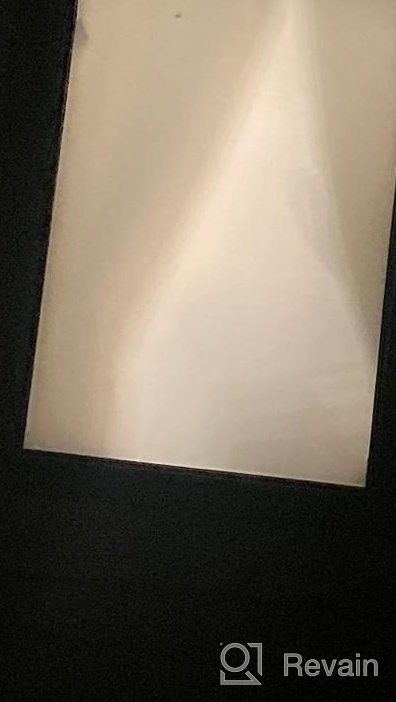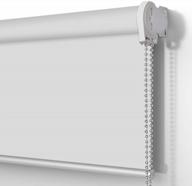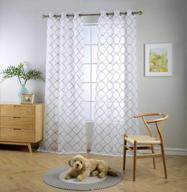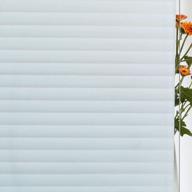
Review on Coavas Frosted Glass Window Film - 118 X 35.6 Inches - Non-Adhesive Static Cling Window Privacy Film For Home, Office & Shower - Anti-UV & Privacy Clings For Better Light Control by Jessica Turner

Installation Tips for my opinion
I just installed my second of these. The first has been up for year(s) and looks like the day I put it up. It's not easy to get the film to fit right up against the frame (which is how I wanted it) but can be achieved with proper tools and some tricks. I suggest scissors, a utility knife, and a straight metal edge with a sharp corner like a putty trowel (or ruler). Here's what I've learned to do (but follow my example at your own risk):1. Make sure you use the "original" corner on the most obvious sides. For example, I put this on one of two sliding doors. The left edge was going to be very visible while the right edge was going to be partially obscured by the other sliding door. Obviously, eye height is also near the top of the door so I made sure to use the original edge/corner on the top and left and put my cuts on the bottom and right.2. Measure and cut the film with an inch or so extra. It's actually harder to cleanly cut away a small amount (e.g. 1/2 or 1/4").3. As they say, wet the door pretty heavily. This helps you avoid and remove air bubbles. I actually took the back film off a foot or so at a time. On the plus side, a little rolled back protector prevented it from trying to "grab" the entire door at once. On the downside, the backing tended to grab water off of the door so I got a worse finish at the bottom. Yon can probably get the best of both worlds by re-applying water as you peel away the backing.4. Start with the original corner. Get it positioned and slowly work your way across the short side of the window. For example, I start in the top left and make sure the top of the window is lined up. If the film isn't flush, push the air bubbles towards the edge; this will tend to "tug" a little film with it. If it's lined up nicely, you can work the other way (this will help you later). Especially on a full door, you may need help to prevent the film from sliding (too much water can actually contribute to this).5. Work down the second original edge. You're going to slowly work a large and larger "triangle". Actually start on the edge that's already finished and work your way diagonally towards the next few inches of the long edge. Pull the air bubbles and ridges away from the finished edge (in my case down), securing the finished edge with light pressure so you don't pull the film away. You need to get all of the bubbles and folds out so the material can stretch to the in-process edge. As you get close to the long edge, you can "pull" towards it if needed -- the film can be stretched a little bit. This can be hard at first (pulling away from the finished edge) so you may need help. If you're really close, push air bubbles (and film) towards the frame. If not, pull it back a couple inches and try again (pulling towards the edge a few inches below your working area). If you're having issues with a big gap, try working the bubbles "down" and towards the in-process edge to encourage film to go in that direction.6. Once you've finished both original edges, at least half of the window (that triangle you've created) should be securely attached. You've probably made some progress down the other side "naturally" (I was a foot or two ahead of the unfinished side. By the time you're at the bottom of the door, you've probably pushed air out of at least half of the opposite side.7. The hardest part of the process is cutting the two non-original edges flush. Even with a sharp utility knife, I had trouble getting a clean cut on my first attempt. The film will tend to tug and shift. I eventually realized that I needed to put pressure on the film while cutting. Ideally you want something metal like a ruler or (even better) a putty trowel. I managed to do a pretty good job the second time with a hard plastic edge, but did cut away/damage the piece of plastic. It also had a rounded corner which made for trouble cutting the last corner (below).You want to place the metal edge right up against the frame so you can cut a clean line without letting the film shift. I also found that it was better to work towards the existing cut. For example if I start at the top of the door, I actually had the most success cutting "upwards". If I cut down, it was more likely to catch and tug the plastic. So I cut the first say 6 inches. Move the tool down. Cut the next 6 inches. Each time I finish the cut, the extra plastic falls to show me that I've cut through. CAUTION: I certainly scored my frame in a couple of places, mostly working on the corner (below). If that's an issue, you may want/need some additional tooling (but I don't know what to suggest).The corners are the hardest and I never got it perfect. The first two corners are easier because you can cut "towards" the edge, the tool holding the film down helps ensure a clean finish, and the material releases once you've cut far enough (but take care not to score the frame). The last corner is the hardest. At least one of the directions, you're dealing with a lot of extra material. Consider cutting the corner off (i.e. a diagonal cut) so you have less excess material. Wait until the end so you cut the right amount. Hopefully your "ruler" has a pretty sharp corner to help. If I did it again, I might even use scissors to cut from the outside in, BUT the hardest thing to do is to remove a sliver of material so you have to be very precise. You could even cut the film a hair short and try to stretch it to the edge while removing air.Hope this helps and good luck!

- INSTALLATION TIPS – Before installation, make sure your window are completely clean and the BACKING PROTECTIVE FILM is removed; During installation, please spray a lot of water both on the glass surface and smooth side of window film for effective attachment; After installation, please trim the edges and leave 0.2 inches between the film edge and the window edge to squeeze out air bubbles easily.
- May compromise the aesthetic of the existing window design
New products
Comments (0)
Top products in 🪟 Window Treatments

Stylish And Functional Blackout Roller Shades For Home Or Office Use: Light Grey Custom Window Shades With Energy-Saving UV Protection And Elegant Design

48 Review

MIUCO White Sheer Embroidery Trellis Design Grommet Curtains 95" Long For French Doors - 2 Panels (2 X 37" Wide)

41 Review

Red And White Stripe Room Darkening Window Curtains With Grommet Top - Set Of 2 Panels, Each 52"X84" - DriftAway Mia Stripe Collection

52 Review

Enhance Your Privacy And Comfort With Our Window Film – Stained Glass Door Film, Anti-UV & Heat Control, Perfect For Office And Home

43 Review
Another interesting products

White Metal Wedding Arch With Climbing Plants Decoration, Perfect For Garden Bridal Parties - Adorox 7.5Ft Arbor Set

45 Review

Artificial Hanging Vines, 12 Pack 84 Feet Fake Green Leaf Garlands Home Office Garden Outdoor Wall Greenery Cover Jungle Party Decoration

37 Review

Black Rose Garden Arch By Gardman R350 - 75 Inches Tall, 39 Inches Wide And 19 Inches Deep

41 Review

24PCS BigOtters Artificial Lemon Slices - 2 Inch Assorted Colors Fake Fruits For Themed Party Decor, Kitchen Table Centerpiece & Crafts Projects

34 Review

